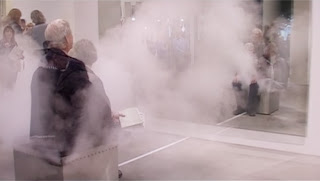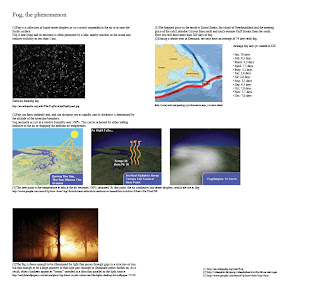Fog, a phenomenon
or architecture
Fog is a collection of liquid water droplets or ice
crystals suspended in the air at or near the Earths surface. Fog is low-lying
and its moisture is often generated by a lake, nearby marshes or the ocean and
reduces visibility to less than 1 km. The foggiest place in the world is Grand
Banks, the island of Newfoundland and the meeting place of the cold Labrador
Current from north and much warmer Gulf Stream from the south. Here you will
have more than 200 days of fog. During a whole year in Denmark, we only have an
average of 74 days with fog,.
Fog can form suddenly and, and can dissipate just as
rapidly, and its thickness is determined by the altitude of the inversion
boundary. Fog normally occurs at a relative humidity near 100%. This can be achieved by either
adding moisture to the air or dropping the ambient air temperature.
I see fog as an artificially landscape, which covers
its surroundings in its own atmosphere. It creates unique transient atmospheres
or ambiances, which inspire architecture.
The mass of the fog can be enormous and covers whole
cities or simply just be small clouds flying by. The fog is dense enough to be
illuminated by light that passes through gaps in a structure or tree, but thin
enough to let a large quantity of that light pass through to illuminate points further
on.
It can be seen as an architectural material, which has
the ability to alter our understanding of space and place, as well as call
attention to the relationship between architecture and environment.
From distance, fog has a bit of mysteries appeal and
somehow it makes your body either wants to go investigating or just avoiding
it. Being in the middle of it, feels like being excluded from what is going on
outside. Here you can listen to sounds from the outside, but only see
silhouettes of whom the sounds come from. You loss the sense of orientation,
which makes you, feels like being in your own little bubble.
The sounds will also become a bit more vague and
starts to feel like having your ears stuffed.
Another reaction from your body is getting the feeling
of an extra layer of skin. In this case a wet skin, which will cover your body
like clothes. Being in the middle of fog will make you a bit wet or moistly.
Using fog as architecture
If
you ought to make a sum up of the phenomenon fog and its relation to coverings
and the body, you soon will see some similar sign.
Fog
will appear either in a solid mass, which shuts its arms around you, or like
light clouds, which passing by. The relation reminds me a bit of clothes, which
like the fog covers your body totally.
In a
way you can say that you somehow are dressing yourself in architecture.
Fog
appears almost like a low-lying cloud, a solid mass from the outside and a
chilled, blurred and moistly inside, which steals the body’s normal orientation
senses.
Inside
you maybe don’t have any form boundaries, which might help you back on track
and your vision will get distracted.
This
leads to a different and more bodily navigation, where you suddenly starts to
use your hearing sense and also starts to look for colours, which will appear
in the dark. Both of them will help you navigating, whether it is a loud sound
or some bright colours leading the way.
In
the end the architecture is a bit temporarily, because the fog will properly
disappear by time or you will find a way out from it. By that you only get to
wear artificial clothes, which temporarily will serve as another layer skin.
This also means that you have to create something, which also can be used when
the fog is gone. Fog can also be illuminated from the sun and reflections from
here would make a better way of orientation.
A first
conclusion of keyword from fog and architecture will be disorientation because
of the distraction in your senses. The
next will be sound, which you are more depended on, simultaneously while you
feel the sounds a bit more vague. The next is light, reflections, shadows and colours.
The last is fog as a landscape or making of its own world with endless space
without any boundaries, and how to use that space for the citizen/user and
bring those in focus.






































































